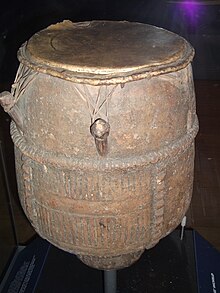Acant drum

The Akan Drum ( English Akan drum is) one in West Africa on the territory of present-day Ghana by the people of Akan einfellige cup made drum , which in today British Museum is housed. It is believed that she came to North America , in the area of western Virginia , as part of the slave trade . It is considered the oldest African American exhibit in the museum and is probably the oldest surviving drum in Africa . It also represents the tension between the three continents.
description
The musical instrument was made from two types of wood. The carved body is made of Cordia africana (Sudan teak). Plant fibers are attached to holders made from the wood of Baphia nitida , with which a deer skin was stretched over the drum.
history
The exact reason why the drum was able to travel to the West on a slave ship can no longer be determined today. It is believed that she was taken on board by either a crew member or a higher rank among the slaves. It is also assumed that it was initially used for tribal dances. Between 1730 and 1745 the instrument was discovered by a certain Reverend Mr. Clerk and passed on to Hans Sloane , an English scientist, explorer and passionate collector. He had seen slaves playing on such drums in Jamaica and took some of these items for himself. But he assumed that they had been made on site. He described it as "a drum carved out of a hollowed out tree [...]". Parts of Sloane's collection, particularly his library, later formed the basis of the British Museum.
It was not until 1906 that it emerged that Sloane's assumption that the drum was an Indian instrument was wrong. As grateful as one is today about this early intercultural musical instrument, its past had to be reopened. With the help of the expertise of the scientists from the Royal Botanic Gardens , the origin of the drum could be determined in the 1970s. One of the types of wood used, Cordia africana , occurs only in Africa and is therefore proof of the African origin of the acant drum.
literature
- Neil MacGregor : A History of the World in 100 Objects . Translated from the English by Waltraut Götting. Andreas Wirthensohn, Annabell Zettel, CH Beck, Munich 2011, ISBN 978-3-406-62147-5 , pp. 643-647.
Web links
- Scientific description at the British Museum: Inventory number Am, SLMisc.1368 .
- BBC : Akan drum , A History of the World in 100 Objects radio series , No. 86.
Individual evidence
- ↑ a b Website of the British Museum ( Memento of October 21, 2012 in the Internet Archive )
- ↑ a b BBC: Akan drum (made early eighteenth century). Made in West Africa, found in Virginia, USA (Engl.)
